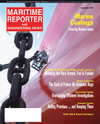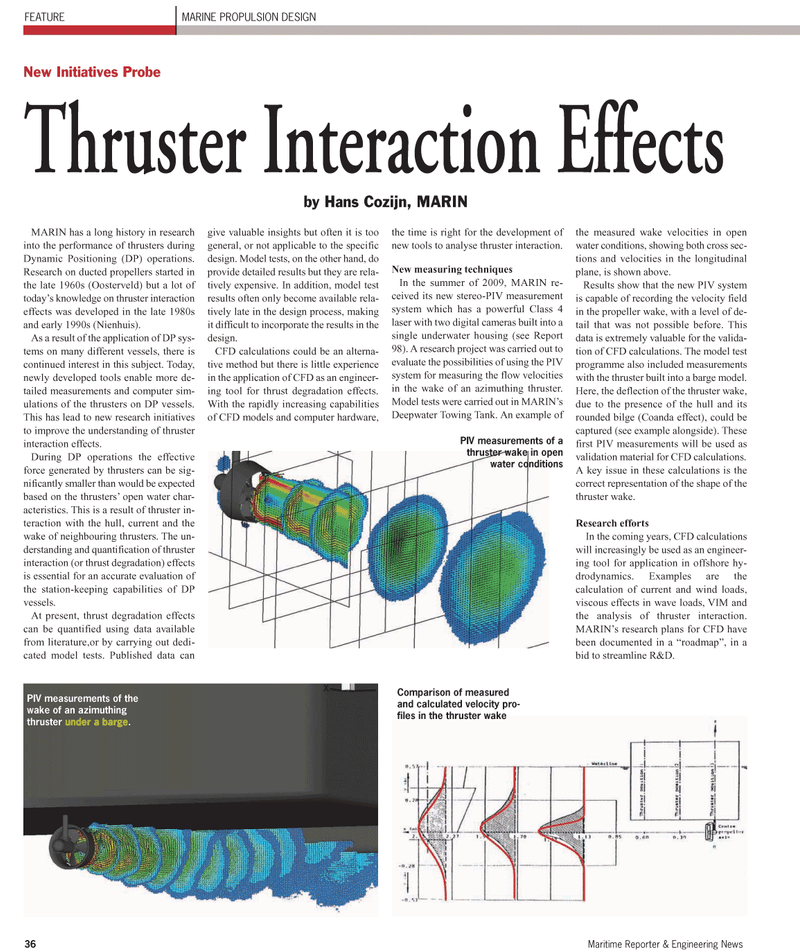
Page 36: of Maritime Reporter Magazine (September 2010)
Marine Propulsion Edition
Read this page in Pdf, Flash or Html5 edition of September 2010 Maritime Reporter Magazine
MARIN has a long history in research into the performance of thrusters during
Dynamic Positioning (DP) operations.
Research on ducted propellers started in the late 1960s (Oosterveld) but a lot of today’s knowledge on thruster interaction effects was developed in the late 1980s and early 1990s (Nienhuis).
As a result of the application of DP sys- tems on many different vessels, there is continued interest in this subject. Today, newly developed tools enable more de- tailed measurements and computer sim- ulations of the thrusters on DP vessels.
This has lead to new research initiatives to improve the understanding of thruster interaction effects.
During DP operations the effective force generated by thrusters can be sig- nificantly smaller than would be expected based on the thrusters’ open water char- acteristics. This is a result of thruster in- teraction with the hull, current and the wake of neighbouring thrusters. The un- derstanding and quantification of thruster interaction (or thrust degradation) effects is essential for an accurate evaluation of the station-keeping capabilities of DP vessels.
At present, thrust degradation effects can be quantified using data available from literature,or by carrying out dedi- cated model tests. Published data can give valuable insights but often it is too general, or not applicable to the specific design. Model tests, on the other hand, do provide detailed results but they are rela- tively expensive. In addition, model test results often only become available rela- tively late in the design process, making it difficult to incorporate the results in the design.
CFD calculations could be an alterna- tive method but there is little experience in the application of CFD as an engineer- ing tool for thrust degradation effects.
With the rapidly increasing capabilities of CFD models and computer hardware, the time is right for the development of new tools to analyse thruster interaction.
New measuring techniques
In the summer of 2009, MARIN re- ceived its new stereo-PIV measurement system which has a powerful Class 4 laser with two digital cameras built into a single underwater housing (see Report 98). A research project was carried out to evaluate the possibilities of using the PIV system for measuring the flow velocities in the wake of an azimuthing thruster.
Model tests were carried out in MARIN’s
Deepwater Towing Tank. An example of the measured wake velocities in open water conditions, showing both cross sec- tions and velocities in the longitudinal plane, is shown above.
Results show that the new PIV system is capable of recording the velocity field in the propeller wake, with a level of de- tail that was not possible before. This data is extremely valuable for the valida- tion of CFD calculations. The model test programme also included measurements with the thruster built into a barge model.
Here, the deflection of the thruster wake, due to the presence of the hull and its rounded bilge (Coanda effect), could be captured (see example alongside). These first PIV measurements will be used as validation material for CFD calculations.
A key issue in these calculations is the correct representation of the shape of the thruster wake.
Research efforts
In the coming years, CFD calculations will increasingly be used as an engineer- ing tool for application in offshore hy- drodynamics. Examples are the calculation of current and wind loads, viscous effects in wave loads, VIM and the analysis of thruster interaction.
MARIN’s research plans for CFD have been documented in a “roadmap”, in a bid to streamline R&D.
New Initiatives Probe
Thruster Interaction Effects
FEATURE MARINE PROPULSION DESIGN
PIV measurements of a thruster wake in open water conditions
PIV measurements of the wake of an azimuthing thruster under a barge. by Hans Cozijn, MARIN
Comparison of measured and calculated velocity pro- files in the thruster wake 36 Maritime Reporter & Engineering News

 35
35

 37
37
